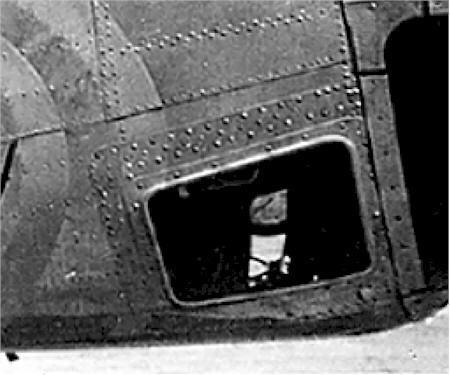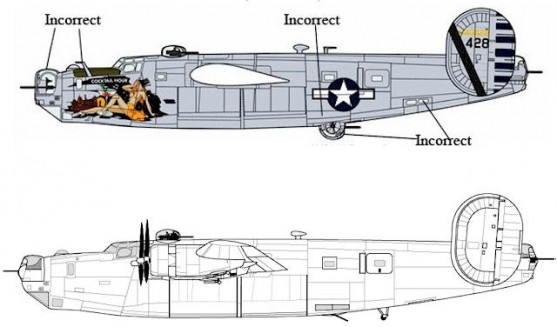Camouflage & Markings
..and the New Hasegawa B-24 Kit
by Alan Griffith
2008 will see my first book released. Coincidentally, it is on nose-turreted versions of the Consolidated B-24 Liberator in USAAF service. In response to the announcement by Hasegawa of their B-24J ’Cocktail Hour’, I thought I should share with you the details of this B-24J obtained through my research. The following information is provided to you as a basis by which you can give the kit a fair and honest review. This information was provided to DragonUSA in early March and was reportedly passed on to Hasegawa so that they could make some corrections to their kit prior to release.
In June, Hasegawa will be releasing the second iteration of their B-24 kit, this time a B-24J. This kit will presumably be released in the markings they advertised on Dragon USA’s web site (below), those of B-24J-160-CO 5AF 64BS 43BG 44-40428 “Cocktail Hour”.
B-24Js differed markedly from one another depending upon who manufactured them. Judging from the above drawing, Hasegawa seems to have combined the characteristics of several different manufacturers and blocks, sadly failing to provide modifications that were done to the basic B-24 based on theatre of operations and the Air Force it flew with.
The following drawings and information are from my forthcoming book, Consolidated Mess: Recognition Guide #1 – The Illustrated Guide to Nose-turreted B-24 Production Variants in USAAF Combat Service. This book will have a great deal of hitherto unpublished information about the B-24 nose-turreted versions gathered from government documents, photos, manuals, and other researchers. “Consolidated Mess” will enable anyone knowing a model, block number and/or serial number to determine what was the external appearance of the aircraft, including type of turrets, etc.
Analysing the Cocktail Hour
“Cocktail Hour” was a B-24J-160-CO of the 5AF 64BS 43BG, serial number 44-40428. As a B-24J-160-CO with this serial number it would have had the following characteristics:
- Nose turret was a Consolidated A6B, not the Emerson shown in the ad. The Emerson would not be used until a later block. A close examination of the photo suggests it may be a replacement nose turret, specifically a lighter A6C/SAC-7 tail turret. In either case, since it was a Consolidated turret, the nose gear doors would continue to retract inside the aircraft when the nose gear was down.
- As manufactured, the aircraft’s tail turret was a Consolidated A6B (which Hasegawa put in their B-24D kit, incorrect for that version as well as incorrect for many J’s).
- The two small fuselage observations windows on the lower rear of the aircraft called “tunnel windows” were not present, having been dropped as of B-24J-160- CO serial number sn44-40413.
- The aircraft would have the flush pitot, not the large ram’s horn pitot. The ram’s horn pitot was dropped as of the J-95-CO block aircraft.
- The window immediately behind the bombardier position would have a raised lip around it vs being totally flush with the fuselage.
Example of bombardier observation window such as that found on ”Cocktail Hour”. Note the heavy riveting. This window was added post-production at a stateside modification centre. Later, factory-installed observation windows would be flush with the fuselage.
In addition to the above particulars, this aircraft was modified according to the 5th Air Force requirements. These modifications were known as the Hawaiian Air Depot Modifications. The Air Forces in the various Pacific Theatres each had specific modifications to their B-24s that they required. These modifications were carried out either in Hawaii or in Australia and took place throughout the war. Late block B-24Ms are seen carrying these modifications.
B-24M-20-CO of the 5th Air Force 65 BS, 43 BG, showing modifications and tail wheel (small bump under rear fuselage) typical for Liberators of this Air Force.
One modification that occurred to nearly every B-24 in the Pacific regardless of Air Force was the replacement of the tail skid with a tail wheel of several different variations.
The modifications specific to the 5th Air Force were:
- Removal of the ball turret
- Replacement of the ball turret with a twin hand-held .50 caliber gun position.
- Observation windows for the hand-held bottom gun position were fitted to sides of the fuselage.
For detailed photos, drawings and information about all of the above I’d have to direct the reader to my book. In the meantime, the following drawings show Hasegawa’s potential errors and the correct configuration of “Cocktail Hour”. This is also shown in the photo of “Cocktail Hour” at the bottom.
This article was originally published in IPMS Stockholms Magazine in May 2008




